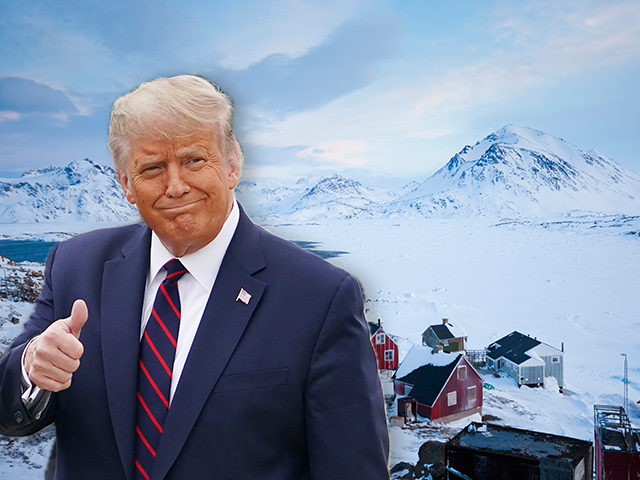How Much Is Greenland?
Donald Trump Jr. recently flew to Greenland for what he described as a “personal day-trip,” which is a pretty specific type of personal trip considering it involved a private jet nicknamed Trump Force One, a few MAGA hats, and a bunch of pictures for social media. Oh, and the trip came right after his father, President-elect Donald Trump, declared that buying Greenland was “an absolute necessity” for the U.S. So yeah, this wasn’t exactly a spur-of-the-moment vacation.
Now, obviously, Denmark said no—again—but let’s indulge this idea for a moment. If the U.S. were to buy Greenland, how much would it cost? Sure, it’s a little weird to think about pricing a giant chunk of ice like a commodity, but real estate agents sell houses in Antarctica, so here we are.
Let’s start by pricing Greenland like farmland. If we use farmland values from Newfoundland and Labrador—which average about $6,481 per acre—we’d get a cool $3.47 trillion for the whole island. Yes, trillion, with a “T.” That’s roughly the size of Germany’s economy, except instead of BMW factories and bratwurst festivals, it’s mostly ice and musk oxen.
Of course, most of Greenland is uninhabitable and permanently frozen, so pricing the entire island at farmland rates is, well, generous. A more realistic approach is to look at the portion that could be farmland in the future. Estimates suggest that between 5.35 million and 16.1 million acres might become viable for agriculture due to climate change. At those numbers, Greenland’s farmland would be worth between $34.7 billion and $104.4 billion, depending on how ambitious you want to be about the whole “Greenland as the breadbasket of the Arctic” thing.
Valuing Greenland Like a High-Growth Stock
Let’s try a different method: pricing Greenland like a high-growth tech stock. The island has a GDP of about $3 billion, but a hefty $600 million of that comes from subsidies from Denmark. Without those subsidies, Greenland’s independent GDP is $2.4 billion.
Now, in financial markets, high-potential assets regularly trade at 50x to 100x earnings. If you apply a 125x multiple, the kind you might give a startup with big future prospects but very little actual profit today, you get $300 billion. Sure, it’s a tech-stock-like multiple, but this isn’t just any chunk of ice. Greenland is sitting on a treasure trove of rare earth metals—the stuff you need for electric cars, smartphones, and missile systems. Whoever controls Greenland controls a key piece of the 21st-century economy.
The remote village of Ittoqqortoormiit, Greenland. (Rod Long/Unsplash)
If valuing Greenland like farmland or a high-growth stock feels too speculative, we can always turn to history. The U.S. bought Alaska from Russia in 1867 for $7.2 million, or about $140 million in today’s dollars. Back then, critics called it a bad deal—a frozen wasteland with little value. But once we found oil and gold, Alaska started to look pretty smart.
Then there’s the 1946 offer, when the U.S. reportedly offered Denmark $100 million for Greenland, which would be about $1.4 billion today. Denmark declined, obviously, and now here we are, trying to figure out if $300 billion sounds insane or genius.
What’s in It for Greenlanders?
Of course, buying Greenland isn’t just about handing over a check and getting the keys. Greenland has 56,000 residents, and they might have something to say about being bought. To make the offer more attractive, the U.S. could double Denmark’s current subsidy, committing $1.2 billion annually, or about $21,429 per resident per year. That’s not exactly Monopoly money, and it might help sell the idea that joining the U.S. could mean better infrastructure, healthcare, and education.
We could also promise the Greenlanders a high level of autonomy. There’s no reason to suppose that they would have to give up their current systems of government to become a part of the United States. They could be a semi-autonomous territory, a commonwealth like Puerto Rico or Northern Mariana Islands. We could promise more autonomy than they currently enjoy under rule from Denmark.
And what’s in it for Denmark? Well, they’d be relieved of that $600 million annual subsidy and would pocket a very generous $300 billion in cash. For context, Denmark’s entire GDP is around $400 billion, so that’s a pretty good payday.
Strategic Value: Owning the Arctic Future
Beyond the economics, there’s the whole geopolitical angle. Greenland is a key Arctic asset, home to Thule Air Base, one of the U.S. military’s most important outposts. With climate change opening new Arctic shipping routes, owning Greenland would give the U.S. control over emerging trade corridors and cement its dominance in the region.
Trump clearly gets the strategic value. Following Trump Jr.’s visit, he posted on Truth Social that Greenland “needs safety, security, strength, and peace!” He even shared a video of a Greenlander urging the U.S. to “free” the island from Denmark’s colonial rule. Sure, the guy in the video reportedly had a minor drug conviction, but hey, the message was clear: Trump wants Greenland, and he’s willing to pitch it however he can.
Look, buying Greenland is probably not happening. Denmark said no, Greenland’s leaders are focused on greater autonomy, and even if we slapped $300 billion on the table, it’s hard to see this deal going through. But it’s still fun to think about, because Greenland is one of those rare geopolitical assets that might actually be worth it.
At $300 billion, the U.S. would secure vast mineral wealth, control key Arctic trade routes, and gain a strategic foothold for generations. Compared to the $300 billion we spend annually on interest payments for the national debt, it doesn’t sound so crazy after all. Real leaders don’t just think about today—they think about tomorrow’s gains.
So, will the U.S. buy Greenland? Probably not. But if someone ever does, we’ll look back and wonder why we didn’t offer more.
